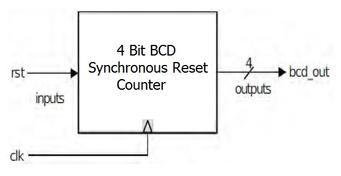D Flip-Flop with Synchronous Reset: Verilog Implementation
Advertisement
This article covers the design and implementation of a D flip-flop with a synchronous reset. We’ll explore the symbol, Verilog code, test bench, simulation results, and RTL schematic.
D Flip-Flop Symbol
The following image depicts the symbol for a D flip-flop with a synchronous reset:

D Flip-Flop Verilog Code
Here’s the Verilog code for a D flip-flop with a synchronous reset:
module d_flipflop_synrst(data_in, data_out, clock, reset);
input data_in;
input clock, reset;
output reg data_out;
always @(posedge clock)
begin
if (reset)
data_out <= 1'd0;
else
data_out <= data_in;
end
endmodule
In this code:
- `data_in` is the input data.
- `clock` is the clock input. The flip-flop's state changes on the positive edge of the clock.
- `reset` is the synchronous reset input. When `reset` is high on a rising clock edge, the output `data_out` is set to 0.
- `data_out` is the output of the flip-flop.
## D Flip-Flop Verilog Code Testbench
This Verilog testbench verifies the functionality of the D flip-flop.
```verilog
module Tb_dflipflop_synrst();
reg data_in;
reg clock, reset;
wire data_out;
d_flipflop_synrst UUT(.data_in(data_in), .data_out(data_out), .clock(clock), .reset(reset));
initial begin
// Initialize Input Stimulus
data_in = 0;
clock = 0;
reset = 0;
end
always #100 clock = ~clock; // Generate a clock signal
initial begin
#200 data_in = 1'b1; reset = 1'b1;
#200 data_in = 1'b1; reset = 1'b1;
#300 data_in = 1'b1; reset=1'b0;
#600 data_in = 1'b0;
#500 data_in = 1'b1;
#200 data_in = 1'b0;
#400 $stop;
end
endmodule
The testbench applies various input stimuli to the flip-flop and monitors the output to ensure correct behavior, including:
- Initializing inputs.
- Generating a clock signal with a period of 200 time units.
- Applying different values to
data_inandresetat different times. - Using
$stopto terminate the simulation.
D Flip-Flop Simulation
The simulation results should demonstrate the functionality of the D flip-flop, showing how the output changes based on the data input and clock signal, and how the reset input affects the output.

D Flip-Flop RTL Schematic
The RTL (Register-Transfer Level) schematic provides a graphical representation of the D flip-flop’s internal structure.

Advertisement
 RF
RF



